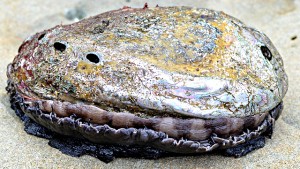About a month ago, thousands of abalone and other invertebrates washed up along the Sonoma coast, killed by what people thought was probably a red tide, a.k.a. a harmful algal bloom. Phytoplankton—photosynthetic organisms like algae and bacteria—can multiply in number, turning the water red with their bright-colored cells and wreaking havoc on marine organisms. An interdisciplinary team of researchers banded together to find out what was going on along the Sonoma coast. Within a few weeks, they’d figured it out: sure enough, it was a red tide.
This was the first time a red tide had widespread impact on wildlife along the coast of California. From Bodega Bay to Salt Point, 50 miles north, invertebrates like abalone, urchins, and gumboot chitons were affected by the red tide. I talked with Laura Rogers-Bennett, Senior Biologist Specialist with the California Department of Fish and Game and the UC Davis Wildlife Health Center, who did surveys to quantify the extent of the damage. She and her colleagues surveyed several sites and found a lot of dead abalone. At Fort Ross, 30% of the abalone had died. At Salt Point, abalone mortality was 12%, and at Timber Cove, mortality was 25%. They took tissue samples from abalone and other invertebrates, and they conducted underwater surveys to look at the geographic distribution of affected organisms.
Red tides can kill marine life in two ways. The first way is by depleting the oxygen in the water, during the algal bloom and during the subsequent die-off and decomposition of the phytoplankton. With low levels of oxygen in the water, marine life suffocates. Red tide events that kill through oxygen depletion have particular characteristics. They are usually small and localized—the size of a large living room, says Rogers-Bennett. They often occur in areas with very little water movement, like the back of coves, and they affect all the organisms in the area, including the fish, which either die or swim away. Recent underwater surveys indicated that this red tide was not killing via oxygen depletion. For one, the area affected was far larger than a living room. And the red tide affected organisms in multiple patches, some of which were in very exposed areas, not just the still backwaters of coves. Plus, the fish did not seem to be affected. Because of this evidence, scientists suspected the phytoplankton bloom was releasing a biotoxin.
To identify the biotoxin, the researchers sent water and tissue samples to Rita Horner at the University of Washington and David Crane at Fish and Game’s Office of Spill Prevention and Response. They determined that the most abundant phytoplankton species was a dinoflagellate called Gonyaulax spinifera, which releases a toxin called a Yessotoxin. However, the dinoflagellate and the toxin are poorly understood, says Rogers-Bennett. Yessotoxin was present in very low amounts—about one part per billion—and we don’t know how much toxin must be present for an organism to suffer ill effects. So we don’t know for sure whether Gonyaulax spinifera and its Yessotoxin are responsible for the death of the invertebrates, or whether the true guilty party is some other, unidentified toxin. Rogers-Bennett and her colleagues are seeking funding to do additional tests of the Yessotoxin, its toxicity, and its effects on the invertebrates.

